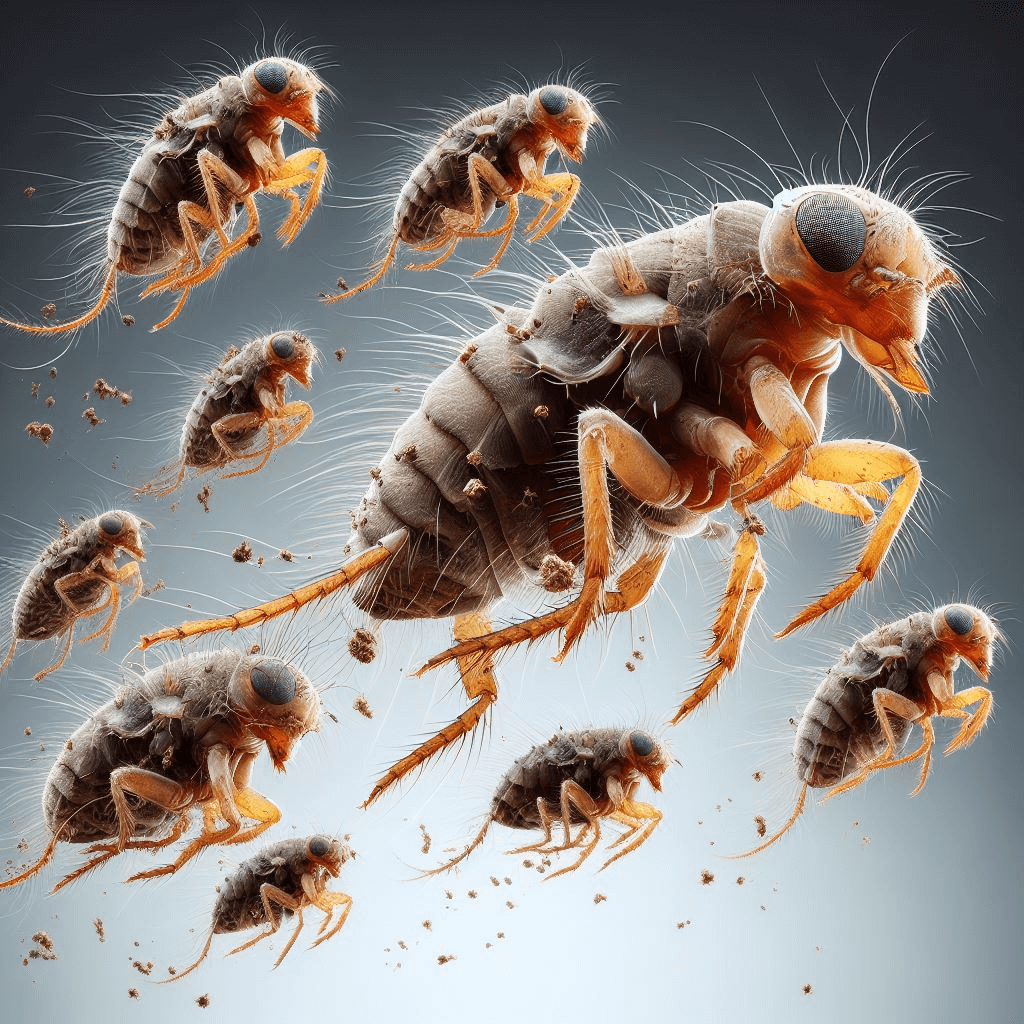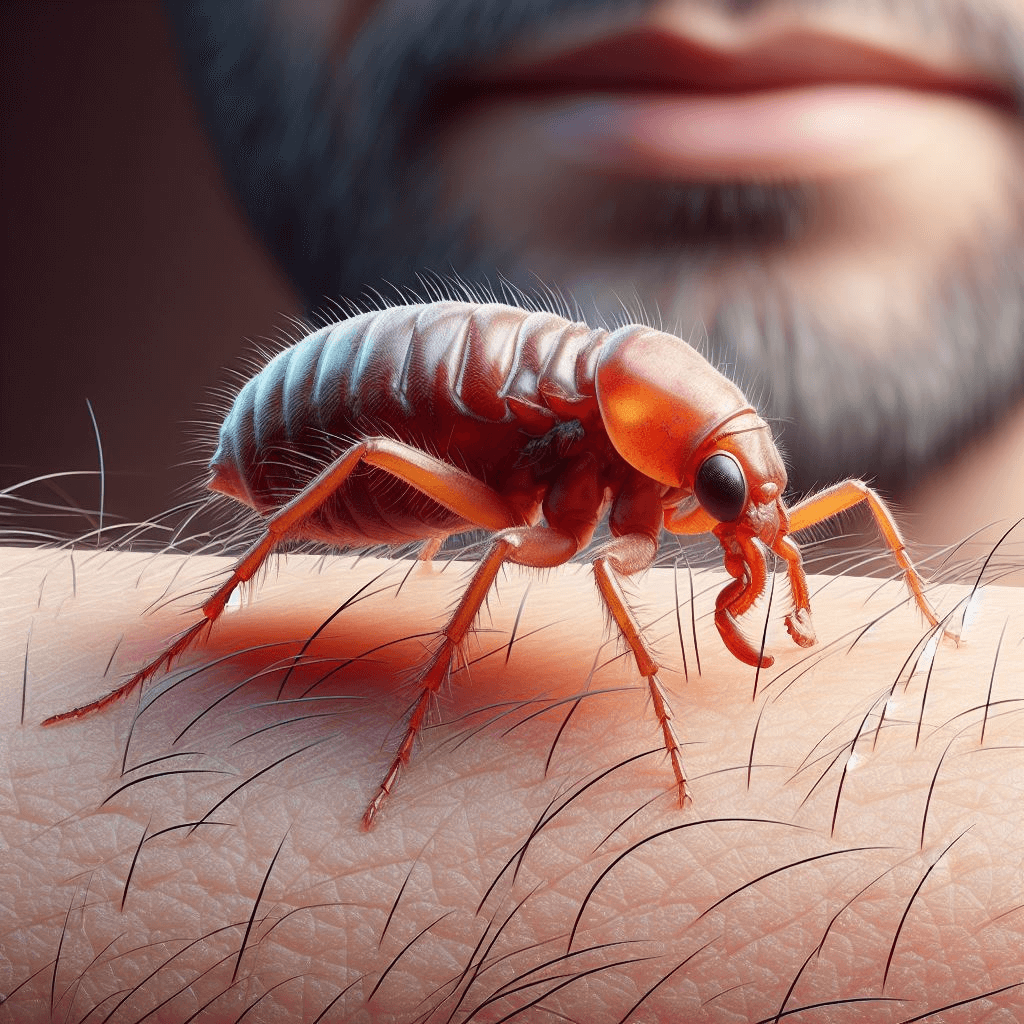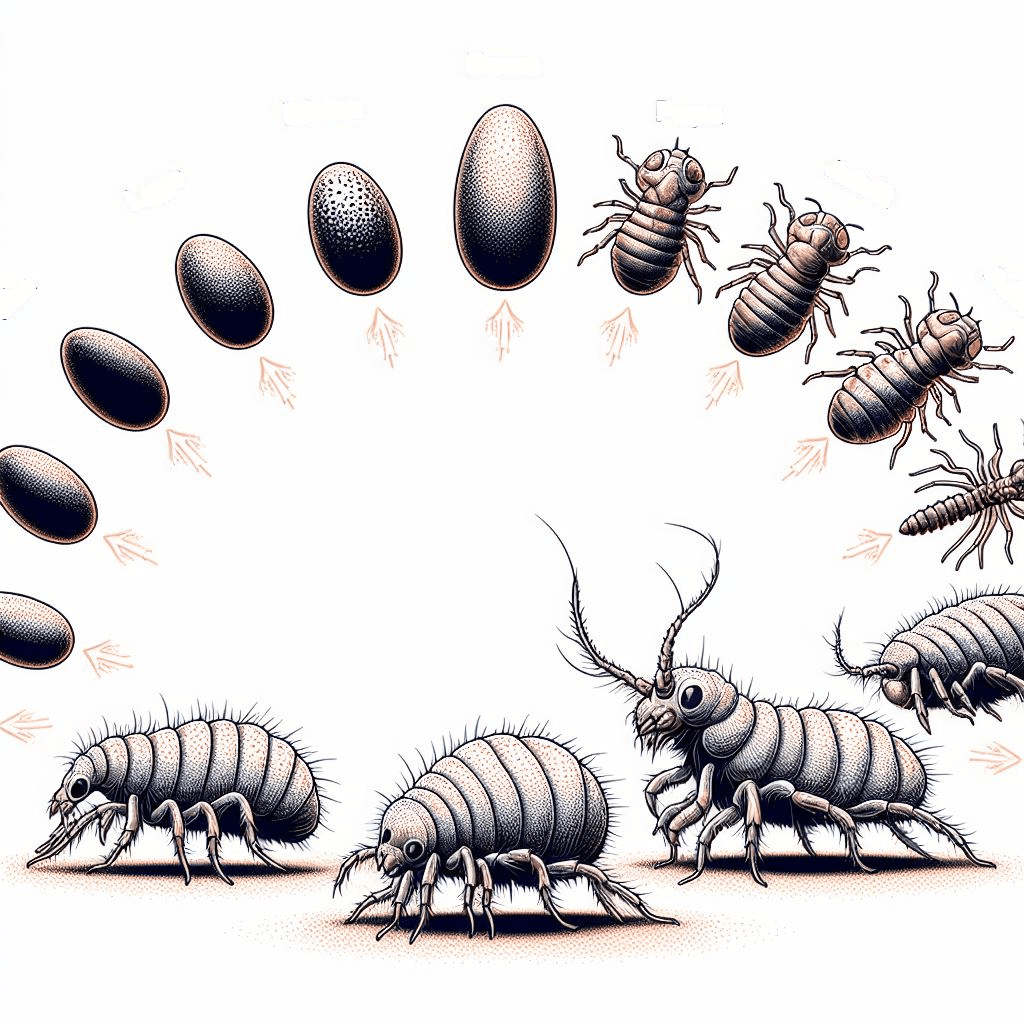Fleas are small, wingless insects that bother our pets. They’re in the order Siphonaptera. Even though they can’t fly, they can jump really far in one leap.
These pesky parasites are external parasites that feed on the blood of mammals and birds. Their bodies are flat with hard plates, making it easy for them to move through animal fur or feathers.
Understanding the Flea Life Cycle: Insights for Effective Control
Unlock the mysteries of the flea world by delving into the intricacies of the flea life cycle. Gain valuable insights into the stages of development, from eggs to larvae and pupae to adult fleas. Understanding this cycle is crucial for implementing effective control measures and preventing infestations.
How Long Do Fleas Live? Unveiling the Lifespan of Fleas
Explore the lifespan of these tiny but resilient pests by discovering how long fleas live. Understanding the duration of a flea’s life is essential for devising targeted and sustainable strategies for control. From their early stages to adulthood, learn how to disrupt their life span and keep your surroundings flea-free.
Where Do Fleas Lay Their Eggs? Navigating the Secret Locations
Delve into the secretive world of flea reproduction by discovering where fleas lay their eggs. Uncover the hidden spots favored by fleas for depositing their eggs, contributing to infestations. This knowledge is pivotal in adopting preventive measures and ensuring a comprehensive approach to flea control.
Do Fleas Prefer Certain Environments? Decoding Flea Habits
Explore the habitats favored by fleas as we uncover the answer to the question: Do fleas prefer certain environments?. Whether in your home, yard, or on your pets, understanding the environments that fleas thrive in is key to effective control. Gain insights into their preferences and take proactive measures.
Flea Behavior and Feeding Habits: Understanding the Enemy
Gain a deeper understanding of your enemy through insights into flea behavior and feeding habits. Learn about how fleas behave, what attracts them, and their feeding habits. Armed with this knowledge, you can develop strategies to disrupt their habits and protect your living spaces from infestations.
Importance of Understanding Flea Life Cycle and Behavior
To fight fleas effectively during a flea infestation, you need to understand their life cycle and behavior. The flea life cycle consists of four stages: egg, larva, pupa, and adult flea.
Each stage has unique characteristics and demands specific environmental conditions for development. By comprehending these four stages well, we can implement targeted strategies for eradication.
Understanding flea behavior helps us know how they interact with hosts and spot risks in infestations. Fleas latch onto animals like dogs, cats, or humans to feed on blood for survival and reproduction.
Pets can get uncomfortable and have health problems due to fleas feeding on them. Knowing the details of flea life cycle and behavior helps us fight flea infestations better.
With this knowledge of fleas’ biology, we can prevent or get rid of an outbreak. Let’s dive into each stage of the cycle of a flea population—from egg-laying to adulthood—and uncover the secrets of these blood-sucking creatures.
Flea Life Cycle
Egg Stage
The flea life cycle begins with the egg stage, which is often where infestations go unnoticed. Flea eggs are minuscule, about 0.5mm in size, making them nearly invisible to the naked eye. They are white and oval-shaped, resembling tiny grains of salt or dandruff.
A female flea can lay up to 50 eggs a day. If not stopped, one flea with eggs can create a big population. Female fleas prefer warm, humid places like our homes in summer or near heaters for egg development.
Fleas thrive at temperatures around 70-85°F (21-29°C) and humidity levels of 70% or higher. Under proper conditions, flea eggs typically hatch within two days to two weeks.
Larva Stage
Once the first flea larvae or eggs hatch, they enter the larval stage of their life cycle. Flea larvae laying eggs are tiny worm-like creatures with a length of around 1-5mm.
They’re blind and hide in dark places like carpets or bedding. Flea larvae eat organic stuff like other flea eggs, feces, flea dirt, dead skin, and debris in their surroundings.
They eat to grow for several weeks. Some larvae make silk cocoons, while others hide in crevices until the next stage of their life cycle.
Pupa Stage
In the pupa stage, fleas become adults in cocoons made by some larvae. These cocoons protect developing larvae and adult fleas from outside threats as they change into the pupal stage.
Cocoons in the pupal stage get sticky and gather organic debris, blending into the surroundings. This pupal stage can last from a few days to several months, depending on temperature and humidity.
Flea pupae can go into a long sleep called “diapause” if conditions aren’t right. When conditions improve, such as body heat or vibrations hinting at a host, flea pupae leave their cocoons to become adult fleas, completing their life cycle.
Adult Stage
Adult fleas, after leaving their first cocoon stage, are ready to find a host for blood meals. They’re small, about 2-4mm, but can jump and move through fur or clothing easily.
Adult fleas are dark reddish-brown with flat bodies that slide easily through hair or feathers. They have mouthparts made for piercing the skin and sucking blood.
When they find a host, adult fleas will start feeding within hours, biting people or animals many times in their lives. The adult flea phase usually lasts for a couple of weeks to a few weeks but can go up to a year in good condition.
During this time, female fleas can lay hundreds of eggs daily—up to 2,000 eggs over their lifetime. Understanding how flea larvae are in these stages is key to fighting flea infestations and preventing them from causing trouble for our pets and homes.
Flea Behavior

Feeding Habits
When it comes to feeding, fleas have quite a unique approach. These minuscule pests exclusively survive on blood extracted from their host animals. Fleas possess specialized mouthparts designed for this purpose, facilitating their blood-sucking endeavors.
The flea finds a host and uses its mouthpart, called a proboscis, to pierce the skin and reach blood vessels. The proboscis has sharp stylets that pierce the skin, and others suck up blood, feeding the entire flea population around them.
Fleas are persistent feeders and will typically take multiple meals throughout their lifespan. Depending on environmental conditions and the availability of hosts, most adult fleas feed and can feed every few hours or even less frequently if there is an abundant food supply.
A single adult female flea that is capable of consuming up to 15 times its body weight in blood during each feeding session! The duration of feeding may vary between individual adult fleas but usually lasts anywhere from a few minutes to several hours.
Jumping Abilities

Don’t be fooled by their tiny size; fleas are extraordinary jumpers! In fact, they can leap astonishing distances relative to their size. Fleas owe this incredible capability to their unique anatomy that allows them to generate remarkable force when launching themselves into the air.
Fleas have strong leg muscles with resilin pads. These pads quickly recoil, compressed by powerful leg muscles, propelling the flea upward at over 150 times its body length!
This means that if humans had such jumping abilities, we could effortlessly leap over tall buildings in a single bound! During these extraordinary jumps, fleas cover impressive distances in relation to their size.
On average, they can leap up to 13 inches horizontally, which is about 200 times their own body length. To put this into perspective, if a full adult, female flea, however, were the size of a human, it would be capable of jumping over the length of a football field in just one leap!
Host Selection
Fleas are quite particular when it comes to selecting their hosts. These crafty critters employ various detection methods to locate potential hosts and ultimately decide where to both lay eggs and settle.
Despite their small size, fleas have highly developed sensory organs that assist them in honing in on their desired targets. Using heat sensors located on their antennae, fleas can detect body heat radiating from potential host animals such as dogs, cats, and even humans.
Carbon dioxide emissions from breath also act as an attractant for cat fleas, these tiny parasites. Interestingly, fleas tend to have preferences when it comes to selecting hosts.
While they may infest any warm-blooded animal, including wildlife or livestock if necessary, they usually show a stronger inclination towards certain species. Factors such as the type and odor of skin secretions play a role in attracting or repelling fleas.
Environmental conditions affect host selection. Fleas might choose places like pet bedding or areas where animals often rest. Knowing flea behavior under optimal conditions gives important insights into how these pests survive and thrive.
Understanding how fleas feed with specialized mouthparts helps us grasp the challenges during infestations. Fleas’ amazing jumping abilities are awe-inspiring, given their anatomy allows them to leap extraordinary distances relative to their tiny bodies.
Understanding factors influencing animal host selection enlightens us about why some animals are more prone to become hosts for fleas. Next time you see a flea hopping around or feel its bite, remember the intricate world of flea behavior.
Interactions with Hosts

Impact on host health
When it comes to fleas, their interactions with hosts can have a significant impact on the overall health of both humans and animals. These tiny creatures may seem harmless, but their bites can cause a range of health issues.
The most common problem associated with flea infestations is the allergic reaction to their bites. Some individuals are hypersensitive to flea saliva, which triggers an itchy rash and discomfort.
Scratching these bites can lead to secondary infections if the skin is broken. Another concern related to fleas is the transmission of diseases.
Fleas aren’t disease carriers like mosquitoes or ticks, but they can still indirectly spread certain illnesses. One notable example is tapeworm infection.
Fleas can carry tapeworms. If a dog or cat eats an infected flea while grooming, it can get a tapeworm. It’s crucial to prevent and treat flea infestations quickly to protect the health of both people and pets.
Behavioral
Fleas don’t just cause physical problems; they affect behavior too. Pets with fleas often scratch a lot, bite their fur, become restless, and may change eating or sleeping habits. These changes happen because fleas make them uncomfortable on their bodies and bedding.
When fleas bite humans, it can mess up daily life. The itching and irritation can make it hard to focus at work or school and disturb sleep. A single flea bite can be annoying for weeks.
Conclusion
Knowing how fleas interact with hosts is crucial for effective flea treatment. Flea bites can cause allergies and spread diseases, so it’s important to prevent infestations. Regularly check pets for fleas, use preventative treatments, and keep living areas clean by vacuuming to prevent fleas and reduce the risk of infestations.
Keep your environment comfy for both people and animals by preventing fleas. With the right knowledge and preventive steps, we can keep these little pests away and enjoy life without worrying about annoying flea bites!
Frequently Asked Questions:
Breaking the flea life cycle can take a few weeks to a few months, depending on the methods used.
The time for a flea infestation to go away varies but may take a few weeks with effective control measures.
Fleas lay eggs in various locations within a house, including carpets, bedding, and pet resting areas.
Fleas can survive in a house without pets for several weeks to several months, depending on environmental conditions. Thorough cleaning is essential for removal.








